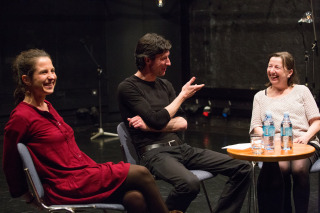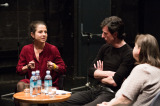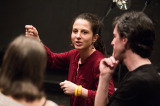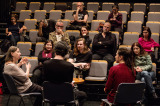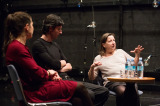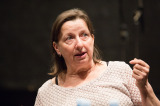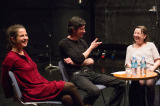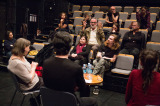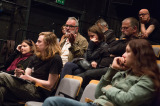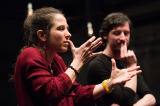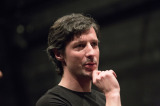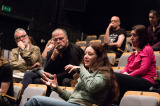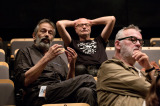Some might say attaching contemporary performing arts practices to traditional folk singing is a futile attempt - because they belong to such different worlds and occupy completely separate dimensions of time that it makes no sense to try and find some common ground lest we seek connections, which are too general and too broad to be relevant. That being sad, the discussion focused on contemplating what these two worlds do have to say to each other as two autonomous entities, but also about each other and how on some universal level they mutually emerge and uncover the other.
Every era is influenced by the traces of previous ones - every period is contemporary at a certain moment in time as well as already on the way to becoming (part of) the past. But that's also the way to discover our roots and at the same time have a peek into the future, to see what can grow out of this present moment. Contemporary artistic movements meet their predecessors in the same way, and artists can research and analyze how they themselves were in some way conditioned by them, because the seeds were already planted in the past, and they are formed and influenced by this past. In very much the same way traditional folk singing looks (in)to its past even though in the present moment, when it's sung and interpreted and developed further by being performed, it is contemporary - and although this might sound like a paradox, the "ancients" continuously teach us how (any) tradition(al) was contemporary at some point in the past because it transcends the constraints of the linear timeline and eludes the terms like past/present/future.
Our folk singing tradition is part of the same process and the songs are continuously reinterpreted as contemporary versions of it(self), but always inspired by its past and unavoidably influencing the ones to come. A traditional folk song is like a living relic coming to life in order to tell us things about ourselves, the way we live today and how we express ourselves. The knowledge and the knowing that belongs to the past yet lives in the present with us and is carried from one generation to another. In words of Bogdana Herman: »The traditional folk song is what carries humankind from one generation to the oher, and not the other way around.«.
Irena Tomažin is the author of 6 artistic projects: »Hitchockove metamorfoze« (2001) in collaboration with Mitja Reichenberg, »Kaprica« (2005), »(S)pozaba kaprice«(2006), »kot kaplja dežja v usta molka«(2008), »Splet okoliščin« (2010) in collaboration with Josephine Evrard and »okus tišine vedno odmeva« (2012). For several years now she also leads »voice« workshops, focused on teaching how to be aware of and open up your own voice, so working with (her) voice is the main tool for creating experimental projects in the field of contemporary performing arts, next to concerts, improvised jam-sessions and workshops, this is mostly the type of her professional engagements. In 2011 she also taught and co-authored 'an exhibition of voices' - »An exibition to hear read« - curated by Mathieu Copeland in Geneva (Switzerland). Five scores of compositions for the voice and body were also published in the book of essays with the same title.
Bogdana Herman is one of those artists whose work is essential for the field of traditional folk songs, especially in the way she opens them up and brings them to life again. For more than three decades now she remains the 'prima donna' of contemporary Slovene folk music. Unlike many of her colleagues who in those turbulent 1960's merged with the artistic avantgarde of the day and blossomed away into the comfortable zone of becoming 'cult legends', Bogdana remains loyal to her quest of finding new directions, new paths and transcending the limitations constraining further development of (contemporary) folk singing. The ballades she used to sing as a member of the Terlep trio and later as a solo artist, singing, creating and (re-)interpreting them, were 'discovered' again in this century by younger generations of 'newly-folk' musicians and became an indispensable part of their repertoire. Moreover, in the past few years Bogdana's supple, crystal clear voice that we are used to listen to in her solo interpretations, began accompanying various instruments and collaborators, like the cymbals of Andi Sobočan, the accordeon of Jure Tori, Tomaž Pengov's guitar or the digital stimuli coming out Borut Savski's computer. And in all these constallations she performs with the same confidence that always convinces the audience, with her subtle yet vivid, emotional and innovative ways. These 'cells of folk singing by Bogdana' are like a living organism, which is perpetually being re-born and the variations of style come to it so naturally that it seems like it's always meant to be this way. (by Katarina Juvančič)
Boštjan Narat holds a Ph.D. in Philosophy and also teaches history, but for more than a decade now he is also performing as a musician, writing essays and giving lectures. In 2001 he was the founding member of the music band called Katalena, whose main focus lies in reinterpreting Slovene folk music heritage. In the last ten years the band produced five albums: (Z)godbe (2002), Babje leto (2004), Kmečka ohcet ali tretji prispevek k slovenski blaznosti (2006), Cvik cvak! (2008) and Noč čarovnic (2011), they had concerts all over Slovenia and several times abroad. In 2010 Boštjan's first album as independent songwriter came out, entitled Strah je odveč. It received very good reviews and was acclaimed not only by the audience but in professional circles as well, leading to the 'Album of the Year' Award by the Vikend magazine. He also wrote several theoretical essays on philosophy, published among others in publications such as Poligrafi, Phainomena and Traditiones. And when he has some time left, he also moderates or participates in public debates and round tables tackling topics in the field of philosophy and ethnology.
